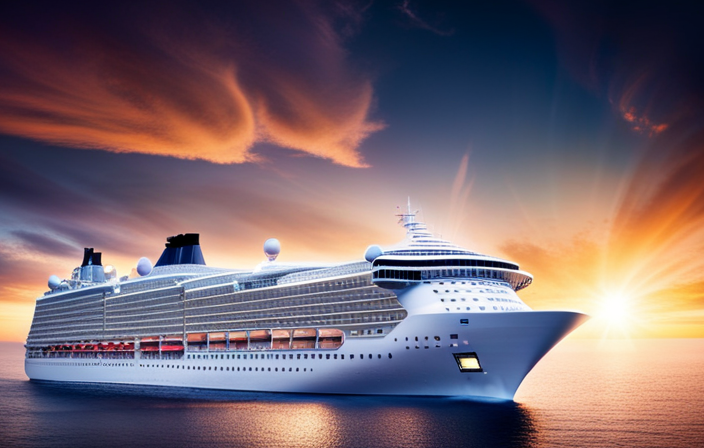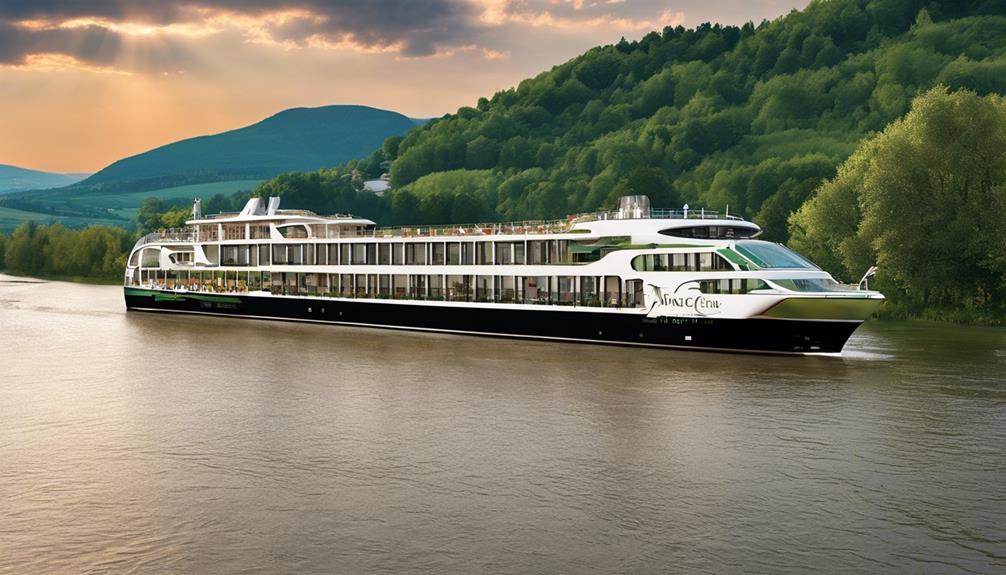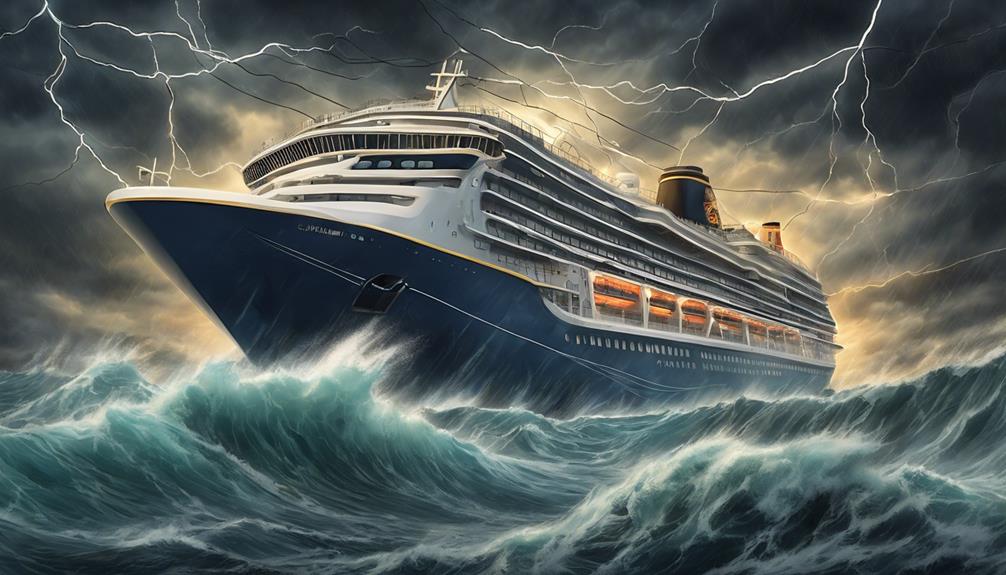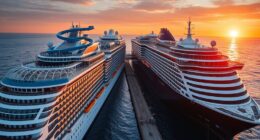Cruise ships, the colossal profit generators of the travel industry, captivate curious thinkers with their extraordinary ability to garner hefty earnings. Yet, have you ever stopped to ponder the techniques these vast maritime behemoths employ to amass their impressive income? Brace yourself for an enlightening exploration as we delve into the economic streams that support these maritime marvels.
Ticket sales, the backbone of cruise ship earnings, bring in billions of bucks annually. Passengers eagerly board these vessels, enticed by the promise of adventure and luxury. Once onboard, their spending spree begins, fueling the second key revenue source: onboard purchases. From lavish spa treatments to delectable dining experiences, guests open their wallets wide to indulge in the opulence that cruise ships offer.
But the financial feast doesn’t end there. Excursions and activities, retail and shopping, casino and gambling revenue, and cruise line loyalty programs all contribute to the treasure trove that cruise ships accumulate. Additionally, chartering and group bookings, as well as onboard services and amenities, fill the coffers even further.
Finally, fuel and energy efficiency measures play a vital role in maximizing profits. By optimizing fuel consumption and incorporating green technologies, cruise lines can minimize costs and increase their economic efficiency.
So, fasten your seatbelts and prepare for an enlightening journey into the world of cruise ship economics. It’s time to unveil the secrets behind their financial success.
Key Takeaways
- Ticket sales, onboard purchases, shore excursions, retail and shopping, chartering and group bookings, and onboard services and amenities are key revenue sources for cruise ships.
- Dining and beverage options, including beverage packages, significantly contribute to the cruise ship’s revenue.
- Spa and wellness services, along with spa packages and wellness retreats, generate additional income for cruise ships.
- Gambling and casinos on board are a significant source of profit, with Carnival leading in average daily gambling revenue in the industry.
Ticket Sales
Cruise ships rake in the cash by selling tickets, giving passengers the opportunity to embark on unforgettable adventures at sea. The success of ticket sales on cruise ships heavily relies on effective marketing strategies and pricing strategies.
To attract customers, cruise lines employ various marketing strategies, such as advertising campaigns, partnerships with travel agents, and targeted promotions. These efforts aim to highlight the unique experiences and amenities offered on board, enticing potential passengers to book a ticket.
In addition, pricing strategies play a crucial role in maximizing revenue. Cruise lines use dynamic pricing models, adjusting ticket prices based on factors like demand, seasonality, and itinerary. By analyzing market trends and consumer behavior, cruise companies can optimize their pricing strategies to maximize profitability.
As we move into the next section about onboard purchases, it becomes clear that ticket sales are just the beginning of a cruise ship’s revenue stream.
Onboard Purchases
When it comes to onboard purchases, cruise ships offer a wide range of dining and beverage options for passengers. From buffet-style dining to specialty restaurants, there are plenty of choices to cater to different tastes and preferences.
Additionally, spa and wellness services are also available on board, providing passengers with opportunities to relax and rejuvenate.
Lastly, casinos and gambling activities contribute to the onboard revenue, attracting those who enjoy testing their luck while at sea.
These three revenue streams play a crucial role in generating profits for cruise ships.
Dining and beverage options
Indulge in a variety of mouthwatering dining and beverage options that will leave you craving for more. Cruise ships offer an array of dining experiences, ranging from casual buffets to elegant gourmet restaurants. With options like international cuisine, specialty steakhouses, and sushi bars, there’s something to satisfy every palate. To enhance your dining experience, cruise lines also offer beverage packages that allow you to enjoy a selection of alcoholic and non-alcoholic drinks throughout your trip. These packages often include unlimited soda, wine, and cocktails, providing great value for those who enjoy a drink or two.
To give you a taste of what’s available, here’s a sneak peek at a sample table showcasing some of the dining and beverage options on a popular cruise line:
| Dining Options | Beverage Packages |
|---|---|
| Main Dining Room | Classic Package |
| Buffet Restaurants | Premium Package |
| Specialty Restaurants | Deluxe Package |
| Room Service | Non-Alcoholic Package |
| Poolside Snacks | Beer and Wine Package |
By offering a wide range of dining and beverage options, cruise ships ensure that guests have a memorable culinary experience. As you indulge in these delectable offerings, you’ll find yourself eagerly anticipating the next section about spa and wellness services.
Spa and wellness services
Pamper yourself with a rejuvenating spa experience that will transport you to a state of pure relaxation and bliss.
Cruise ships offer a range of spa packages and wellness retreats to cater to the needs of their passengers. These packages often include a variety of treatments such as massages, facials, and body wraps, all designed to promote wellness and rejuvenation. The spa facilities onboard are equipped with state-of-the-art equipment and staffed by trained professionals who ensure a high level of service. Passengers can choose from a menu of services and packages that suit their preferences and budgets.
Spa services are an additional revenue stream for cruise ships, generating income through the sale of treatments and packages. With the growing interest in wellness and self-care, these offerings have become increasingly popular among passengers.
Transitioning to the subsequent section, let’s explore another revenue source for cruise ships, which is casino and gambling revenue.
Casino and gambling revenue
Immerse yourself in the thrilling world of casino games and gambling, adding an exciting element to your cruise experience. The casino on a cruise ship is not just a source of entertainment; it is also a significant revenue generator for the company. Cruise lines earn substantial profits from gambling revenue, as passengers try their luck at the various games on offer. Let’s take a look at the table below, which illustrates the average daily gambling revenue for different cruise lines.
| Cruise Line | Average Daily Gambling Revenue |
|---|---|
| Carnival | $350,000 |
| Royal Caribbean | $300,000 |
| Norwegian | $250,000 |
| MSC | $200,000 |
As we can see from the data, Carnival leads the pack with an average daily gambling revenue of $350,000. These numbers highlight the significant contribution of the casino to the cruise line’s overall profits. Moving forward to the next section about excursions and activities, passengers can continue to enjoy a wide range of engaging experiences during their cruise.
Excursions and Activities
When it comes to excursions and activities on a cruise ship, there are three key points to consider.
First, shore excursions and guided tours are a popular option for passengers looking to explore the ports of call and learn about the local culture and history.
Second, water sports and recreational activities, such as snorkeling, kayaking, and paddleboarding, provide an adventurous and active experience for passengers.
Finally, entertainment shows and performances, including Broadway-style productions, comedy acts, and live music, offer a diverse range of entertainment options for guests onboard.
These activities not only enhance the guest experience but also contribute significantly to the cruise ship’s revenue through ticket sales and additional purchases.
Shore excursions and guided tours
Explore the fascinating world of shore excursions and let yourself be swept away by the captivating allure of guided tours while cruise ships rake in their profits.
-
Shore excursions profitability: Cruise ships make a significant portion of their revenue from shore excursions. These activities, organized by the cruise lines, offer passengers the opportunity to explore the destinations they visit.
-
Tour guide income: Cruise ship companies employ tour guides who accompany passengers on these excursions. These guides play a crucial role in providing information, ensuring safety, and enhancing the overall experience. They are paid by the cruise lines and also rely on tips from passengers.
-
Variety of excursions: Cruise ships offer a wide range of shore excursions to cater to different interests and preferences. From historical city tours to adventurous experiences like hiking or snorkeling, there is something for everyone.
-
Partnering with local vendors: Cruise lines often collaborate with local vendors and tour operators to offer unique and authentic experiences. This partnership benefits both the cruise lines and the local communities, providing economic opportunities and promoting tourism.
As we transition to the next section about water sports and recreational activities, the cruise industry continues to find innovative ways to keep passengers engaged and entertained.
Water sports and recreational activities
Indulge in an array of exhilarating water sports and recreational activities that will leave you feeling invigorated and rejuvenated. Onboard our cruise ship, we offer a variety of water sports rentals, ranging from jet skis to paddleboards, catering to all levels of experience. For those seeking thrills, our water park attractions provide non-stop excitement with towering slides and splash zones. Take a refreshing dip in the pool, or unwind in one of our luxurious hot tubs. Our state-of-the-art facilities are equipped with top-of-the-line equipment and safety measures, ensuring a seamless and enjoyable experience for all guests. Engage in friendly competitions with fellow cruisers on our basketball and volleyball courts, or test your skills at our mini golf course. Get ready to dive into the excitement that awaits you. Join us for the subsequent section where we explore the captivating world of entertainment shows and performances.
Entertainment shows and performances
Get ready to immerse yourself in a world of mesmerizing entertainment shows and performances that’ll leave you in awe and wanting more. The entertainment industry on cruise ships is a significant revenue source, attracting passengers and generating income.
Cruise lines invest heavily in providing top-notch shows and performances to keep guests entertained throughout their voyage. These shows range from Broadway-style musicals and comedy acts to magic shows and acrobatic performances. The revenue from these entertainment activities comes from various sources, including ticket sales, merchandise sales, and sponsorships.
Additionally, cruise lines often partner with well-known performers and production companies to enhance the quality of their shows and attract more passengers.
As we transition into the section about ‘retail and shopping,’ you’ll discover how cruise ships capitalize on the desire to shop and indulge in retail therapy while at sea.
Retail and Shopping
Take advantage of the retail and shopping opportunities on board, where you can browse and buy a wide array of luxury goods and souvenirs. The cruise industry has tapped into retail trends and implemented effective marketing strategies to maximize revenue from this aspect of their business. Here are some reasons why the onboard shopping experience is a lucrative venture:
-
Variety: Cruise ships offer a diverse range of products, from high-end designer clothing to duty-free alcohol and fine jewelry. This ensures there is something for everyone, catering to different tastes and preferences.
-
Exclusivity: Many cruise ships collaborate with luxury brands to offer exclusive merchandise that can only be found onboard. This creates a sense of exclusivity and encourages passengers to make purchases they wouldn’t find elsewhere.
-
Convenience: Onboard shops are conveniently located, making it effortless for passengers to indulge in some retail therapy during their cruise vacation.
By capitalizing on these retail opportunities, cruise ships generate substantial income that helps support their operations and other revenue streams, such as casino and gambling revenue.
Casino and Gambling Revenue
The onboard casinos offer an exciting and thrilling experience for passengers, with a chance to try their luck and potentially win big. Online gambling has become increasingly popular, and cruise ships have capitalized on this trend by offering a variety of casino games and slot machines. These games are designed to provide entertainment and keep passengers engaged throughout their voyage. The revenue generated from the casino and gambling activities on cruise ships is significant. In fact, according to industry data, the global cruise industry’s total casino revenue reached $1.9 billion in 2019. This highlights the financial importance of the casino sector for cruise ships. Moving forward, partnerships and sponsorships play a vital role in further enhancing the onboard casino experience for passengers.
Partnerships and Sponsorships
Imagine the excitement and thrill you’ll experience when you step into the onboard casino, where partnerships and sponsorships enhance your gambling adventure and transport you to a world of endless possibilities.
Partnerships and sponsorships play a crucial role in generating alternative revenue streams for cruise ships. Here are four ways these collaborations benefit both the cruise line and its partners:
-
Brand exposure: By partnering with well-known brands, cruise ships attract more passengers who are eager to experience the added benefits and services associated with these partnerships.
-
Exclusive promotions: Partnerships allow cruise ships to offer exclusive promotions and discounts to their passengers, creating a sense of exclusivity and enhancing the overall customer experience.
-
Product placement: Sponsors often have the opportunity to showcase their products and services onboard, increasing their visibility and potential sales.
-
Co-branding opportunities: Collaborating with partners enables cruise lines to create co-branded merchandise and experiences, providing additional revenue streams.
With these lucrative partnerships and sponsorships, cruise lines can maximize their revenue potential and offer passengers an unforgettable gambling experience. Transitioning to the next subtopic, let’s explore how cruise line loyalty programs further enhance the onboard experience.
Cruise Line Loyalty Programs
Cruise Line Loyalty Programs offer a range of benefits and rewards for loyal customers. These programs typically consist of tiered membership levels, where customers can earn points and move up to higher levels based on their cruise history.
As customers progress through the tiers, they unlock various perks such as priority boarding, onboard credit, and complimentary upgrades. In addition to these perks, cruise lines also provide incentives for repeat bookings and referrals, encouraging customers to continue booking with the same cruise line and refer their friends and family.
Benefits and rewards for loyal customers
As a loyal customer, you’ll love the amazing perks and rewards cruise ships offer. Cruise lines understand the importance of keeping their loyal customers happy and engaged, which is why they provide a range of benefits and rewards to show their appreciation.
These loyal customer benefits can include priority boarding, access to exclusive lounges, complimentary upgrades, and onboard credits. Additionally, cruise lines often offer special discounts and savings on future bookings for their loyal customers.
By providing these incentives, cruise lines aim to encourage repeat business and foster customer loyalty.
In the next section, we’ll explore the tiered membership levels and perks that are available to loyal customers, further enhancing the cruise experience.
Tiered membership levels and perks
Customers who have achieved higher tiered membership levels on a cruise ship can enjoy an array of exclusive perks and privileges. These benefits are part of the cruise line’s loyalty program, designed to incentivize repeat bookings and reward customer loyalty.
Here are the top three perks that come with tiered membership levels:
-
Priority boarding: Members with higher tiered levels are granted priority boarding, allowing them to skip the long lines and embark on their cruise vacation faster.
-
Access to exclusive lounges: Higher-tiered members have access to exclusive lounges onboard, providing a serene and luxurious space to relax and socialize with other like-minded travelers.
-
Enhanced onboard amenities: From upgraded cabins and priority dining reservations to spa discounts and complimentary internet access, higher-tiered members enjoy enhanced amenities that make their cruise experience even more enjoyable.
These loyalty program benefits and customer incentives encourage repeat bookings and referrals, ensuring a continued stream of revenue for the cruise ship company.
Transitioning into the next section, let’s now explore the incentives for repeat bookings and referrals.
Incentives for repeat bookings and referrals
Imagine yourself sailing through the crystal clear waters of the Caribbean, basking in the warm sun and savoring the taste of pure luxury. Cruise lines understand the value of repeat customers, which is why they offer enticing incentives to keep passengers coming back for more. One strategy they use is offering repeat customer discounts, where loyal guests receive special rates on future bookings. This not only encourages customers to book again but also helps build long-term relationships with the cruise line. Additionally, cruise lines have referral bonus programs, rewarding customers who refer friends and family to book a cruise. These programs often offer discounts or onboard credits to both the referrer and the new customer. By utilizing these tactics, cruise lines can foster customer loyalty and increase their revenue through repeat bookings and referrals.
Moving on to the next section about ‘chartering and group bookings’, the cruise industry has found yet another way to boost their profits.
Chartering and Group Bookings
Chartering cruise ships and securing group bookings are key sources of revenue for the cruise industry. Chartering benefits the industry by allowing companies to lease out entire ships to private groups or organizations. This provides a guaranteed source of income for the cruise line, as the group pays a fixed fee for the ship and its services.
Additionally, chartering allows the cruise line to customize the experience for the group, offering tailored itineraries and onboard activities. On the other hand, group bookings provide an opportunity for the cruise line to offer discounted rates to large groups, incentivizing them to book together. This not only fills up the ship’s capacity but also generates additional revenue through onboard spending.
By offering chartering options and group booking discounts, cruise lines can maximize their revenue potential. Moving into the subsequent section about onboard services and amenities, passengers can enjoy a wide range of luxurious offerings during their cruise experience.
Onboard Services and Amenities
Chartering and Group Bookings are not the only sources of revenue for cruise ships. Another significant way cruise ships generate income is through onboard services and amenities.
These offerings, such as onboard entertainment and onboard spa services, are designed to enhance the guest experience and entice passengers to spend more on their vacation. From Broadway-style shows and live music performances to state-of-the-art spas and wellness centers, cruise ships offer a wide range of services that cater to the diverse preferences of their passengers.
These amenities not only provide additional revenue streams but also help in building customer loyalty and attracting new clientele. By constantly upgrading and expanding these offerings, cruise lines can continue to generate significant profits.
Moving forward, let’s delve into the next section, which focuses on fuel and energy efficiency measures, a crucial aspect of the cruise industry’s sustainability efforts.
Fuel and Energy Efficiency Measures
One incredible way cruise lines boost their revenue and contribute to a greener future is by implementing mind-blowingly efficient fuel and energy measures. Cruise ships are notorious for their massive fuel consumption, but the industry has made significant strides in improving fuel efficiency.
By adopting advanced technologies and alternative energy sources, cruise lines are reducing their carbon footprint and operating costs. Fuel efficiency measures include the use of advanced propulsion systems, such as diesel-electric engines and hybrid systems, which optimize energy consumption.
Additionally, cruise ships are equipped with state-of-the-art waste heat recovery systems that convert excess heat into usable energy, further maximizing fuel efficiency. Alternative energy sources like liquefied natural gas (LNG) are increasingly being adopted by cruise lines.
LNG significantly reduces emissions of sulfur oxide, nitrogen oxide, and particulate matter, making it a cleaner and more sustainable option compared to traditional fuels. In conclusion, cruise lines are prioritizing fuel efficiency and exploring alternative energy sources to not only improve their bottom line but also contribute to a greener future for the industry.
Frequently Asked Questions
How do cruise ships handle medical emergencies and what are the associated costs?
Cruise ships have medical facilities and trained medical staff onboard to handle medical emergencies. The costs associated with medical emergencies can vary depending on the severity of the situation and the required treatment.
What measures do cruise ships take to ensure passenger safety during the journey?
To ensure passenger safety during the journey, cruise ships implement a range of measures. These include rigorous safety inspections, emergency response plans, trained personnel, surveillance systems, lifeboats, and safety drills for passengers. Safety is paramount.
How do cruise ships manage waste disposal and environmental impact?
Cruise ships manage waste disposal and minimize environmental impact through advanced waste management systems. They employ technologies like onboard incinerators, wastewater treatment plants, and recycling programs to reduce waste generation and pollution.
Are there any additional fees or charges that passengers should be aware of?
Passengers should be aware of potential additional charges and hidden fees when taking a cruise. These may include gratuities, specialty dining, alcoholic beverages, shore excursions, spa services, and internet access.
How do cruise ships handle refunds or compensation in case of itinerary changes or cancellations?
If a cruise ship changes or cancels the itinerary, they usually offer refunds or compensation based on their refund process and compensation policies. However, it’s important to review the specific terms and conditions to fully understand the options available.
What Factors Contribute to the Financial Value of Cruise Ships?
When assessing the financial value of cruise ships, various factors come into play. These include the vessel’s age, condition, size, and amenities. A thorough cruise ship valuation analysis takes into account the potential revenue generated through ticket sales, onboard purchases, and other sources, ultimately impacting the overall financial value.
Conclusion
In conclusion, cruise ships generate revenue through various channels such as ticket sales, onboard purchases, excursions, retail, casinos, loyalty programs, chartering, and onboard services.
To put this in perspective, let’s take a look at the fuel consumption of a typical cruise ship. Did you know that a large cruise ship can burn around 150 tons of fuel per day? That’s equivalent to the weight of 100 elephants! This immense fuel consumption highlights the scale of operations and the financial investments required to keep these floating cities afloat.
Cruise ships are truly a marvel of both engineering and business acumen.










